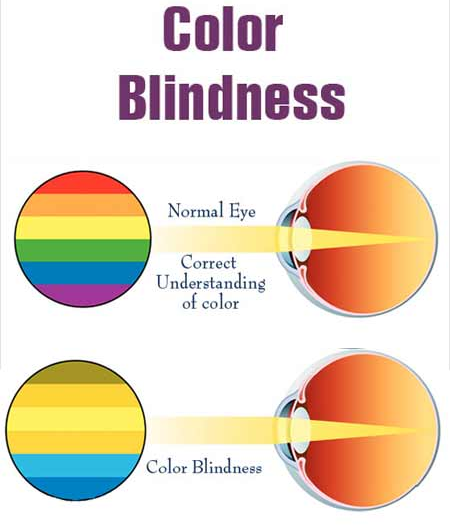Science & Technology
Colour Blindness
- 14 Apr 2022
- 5 min read
For Prelims: Supreme Court Judgement, Film and Television Institute of India, Colour blindness
For Mains: Colour blindness, Health
Why in News
Recently, the Supreme Court has directed the Film and Television Institute of India (FTII) not to exclude candidates suffering from colour blindness from its courses on film making and editing and asked it to make changes to its curriculum instead.
What is Colour Blindness?
- About: Colour blindness is the inability to see colours in the normal way. Colour blind individuals often cannot distinguish between certain colours — usually greens and reds, and sometimes blues as well.
- It is also known as colour deficiency.
- Anatomy: Two types of cells in the retina detect light:
- Rods: These help in distinguishing between light and dark.
- Cones: These help in detecting colour.
- There are three types of cones that see colour — red, green, and blue — and our brains use the information from these cells to perceive colour.
- Colour blindness can be the result of the absence of one or more of these cone cells, or their failure to work properly.
- Different Kinds: Colour blindness may be of different kinds and degrees.
- In a situation where all three cone cells are present but one of them is malfunctioning, mild colour blindness may occur.
- Mildly colour blind people often see all colours properly only when the light is good.
- In the most severe kind of colour blindness, vision is black-and-white, that is, everything appears as a shade of grey. This is not very common.
- Causes:
- Congenital Colour Blindness: Most colour blind people are born with the condition (congenital colour blindness). Congenital colour vision deficiencies are usually passed on genetically.
- This type of Colour blindness generally affects both eyes, and the condition remains roughly the same for as long as the individual is alive.
- Medical Conditions: A problem with colour vision that arises later in life could be the result of disease, trauma, or ingested toxins.
- If colour blindness arises out of disease, one eye may be affected differently from the other, and the difficulty could worsen over time.
- Medical conditions that may increase the risk of getting colour blindness include glaucoma, diabetes, Alzheimer’s, Parkinson’s, alcoholism, leukaemia, and sickle-cell anaemia.
- Congenital Colour Blindness: Most colour blind people are born with the condition (congenital colour blindness). Congenital colour vision deficiencies are usually passed on genetically.
- Treatment: Colour blindness cannot as yet be treated or reversed.
- However, it can be corrected to some extent by wearing special contact lenses or colour filter glasses.
- There is some research that suggests gene replacement therapy can help modify the condition.
- Gender Differentiation: Men suffer from a higher incidence of colour blindness than women.
- Around the world, every tenth male is estimated to have some form of colour deficiency.
- Men of Northern European descent are considered to be especially vulnerable.
- Restriction in Jobs: Colour blindness impairs in some ways the ability to do certain kinds of jobs, such as being a pilot or joining the armed forces.
- However, it depends on the severity of the colour blindness, and the rules in place in different jurisdictions.
- There are an estimated 300 million people in the world with colour vision deficiency.
- Initiative Taken by Government: In June 2020, India’s Ministry of Road Transport and Highways amended the Central Motor Vehicles Rules 1989 to enable citizens with mild to medium colour blindness to obtain a driver’s licence.
What is the Film and Television Institute of India?
- The Film and Television Institute of India (FTII) was set up by the Government of India in 1960, in the premises of the erstwhile Prabhat Studios in Pune.
- Prabhat Studio was a pioneer in the business of filmmaking and shifted to Pune from Kolhapur in 1933.
- It is an autonomous body under the Union Ministry of Information and Broadcasting.







